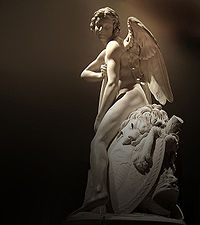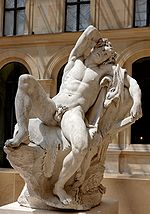
Edmé Bouchardon
Encyclopedia

France
The French Republic , The French Republic , The French Republic , (commonly known as France , is a unitary semi-presidential republic in Western Europe with several overseas territories and islands located on other continents and in the Indian, Pacific, and Atlantic oceans. Metropolitan France...
sculptor
Sculpture
Sculpture is three-dimensional artwork created by shaping or combining hard materials—typically stone such as marble—or metal, glass, or wood. Softer materials can also be used, such as clay, textiles, plastics, polymers and softer metals...
, esteemed in his day as the greatest sculptor of his time and valued as a draughtsman as well.
Biography
Born at Chaumont-en-BassignyChaumont, Haute-Marne
Chaumont is a commune of France, and the capital of the Haute-Marne department. , it has a of 24,039.The city stands on the Marne River and is situated on the railway linking Paris and Basel, which runs over a 52 m tall and 600 m long viaduct built in 1856.- History :Historically the...
, the son of a sculptor and architect, Jean-Baptiste Bouchardon (1698–1762), he became the pupil of Guillaume Coustou and gained the prix de Rome
Prix de Rome
The Prix de Rome was a scholarship for arts students, principally of painting, sculpture, and architecture. It was created, initially for painters and sculptors, in 1663 in France during the reign of Louis XIV. It was an annual bursary for promising artists having proved their talents by...
in 1722. Resisting the barocchetto tendency of the day he was classic in his taste, as if he had taken for his motto, according to the vigorous and perceptive connoisseur the comte de Caylus, "To appropriate for himself the talent of the Ancients and find it again in Nature" "pure and chaste" the 1911 Encyclopædia Britannica asserted, "always correct, charming and distinguished, a great stickler for all the finish that sandpaper could give." During the ten years he remained at Rome, Bouchardon made a striking bust of Pope Benedict XIII
Pope Benedict XIII
-Footnotes:...
(1730).

Fontaine des Quatre-Saisons
The Fontaine des Quatre-Saisons is a monumental 18th-century public fountain, at 57-59 rue de Grenelle in the 7th arrondissement of Paris, France. It was executed by Edme Bouchardon, royal sculptor of King Louis XV , and opened in 1745...
in the rue de Grenelle, Paris
Paris
Paris is the capital and largest city in France, situated on the river Seine, in northern France, at the heart of the Île-de-France region...
, commissioned by the city of Paris in 1739, the first portions of which had been finished and exhibited in 1740, and the completed work completed in 1745. The great loss, on the other hand, is the equestrian statue of Louis XV of France
Louis XV of France
Louis XV was a Bourbon monarch who ruled as King of France and of Navarre from 1 September 1715 until his death. He succeeded his great-grandfather at the age of five, his first cousin Philippe II, Duke of Orléans, served as Regent of the kingdom until Louis's majority in 1723...
, also a commission from the city of Paris, conceived as a monument to France's victory in the War of Austrian Succession (1740–48) but only installed after France's defeat in the Seven Years' War
Seven Years' War
The Seven Years' War was a global military war between 1756 and 1763, involving most of the great powers of the time and affecting Europe, North America, Central America, the West African coast, India, and the Philippines...
(1756–63). That Bouchardon would be commissioned as sculptor was understood from the beginning. Bouchardon did not live to finish this work, which, when the model was produced, was declared the finest work of its kind ever produced in France; he left its completion to Jean-Baptiste Pigalle
Jean-Baptiste Pigalle
Jean-Baptiste Pigalle was a French sculptor.He was born in Paris, the seventh child of a carpenter. Although he failed to obtain the Grand Prix, after a severe struggle he entered the Académie Royale and became one of the most popular sculptors of his day.His earlier work, such as Child with Cage ...
. It was destroyed during the French Revolution
French Revolution
The French Revolution , sometimes distinguished as the 'Great French Revolution' , was a period of radical social and political upheaval in France and Europe. The absolute monarchy that had ruled France for centuries collapsed in three years...
.
For a quarter-century Bouchardon designed the jeton
Jeton
Jetons were token or coin-like medals produced across Europe from the 13th through the 17th centuries. They were produced as counters for use in calculation on a lined board similar to an abacus. They also found use as a money substitute in games, similar to modern casino chips or poker chips...
s, or New Year's tokens distributed by the King, and the medals. Die-cutters working for the mint, executed the dies. the subjects and the mottoes (legendes) were chosen by the Académie des Inscriptions et Belles-Lettres
Académie des Inscriptions et Belles-Lettres
The Académie des Inscriptions et Belles-Lettres is a French learned society devoted to the humanities, founded in February 1663 as one of the five academies of the Institut de France.-History:...
, the Petit-Académie and passed through an elaborate process of critical apoproval, which involved the king. The result is an archive of Bouchardon drawings at the Bibliothèque de l'Institut (for the jetons) and the Musée de la Monnaie (for the medals); a great cache of counterproof
Counterproof
In engraving, a counterproof is a print taken off from another just printed, which, by being passed through the press, gives a copy in reverse, and of course in the same position as that of the plate from which the first was printed, the object being to enable the engraver to inspect the state of...
s at the Bibliothèque National.
His brother Jacques Bouchardon was also a sculptor, who became first sculptor to the king of Sweden.

